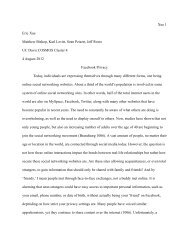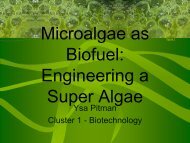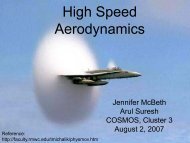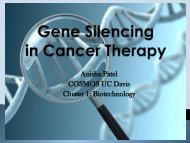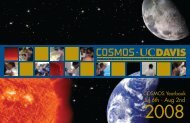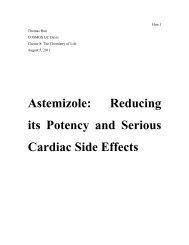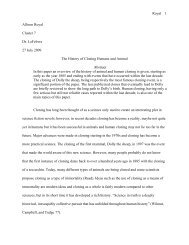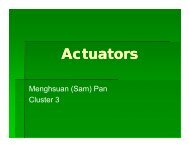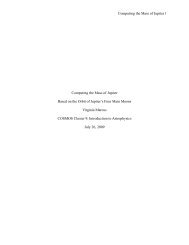Phytoremediation of Heavy Metals - COSMOS
Phytoremediation of Heavy Metals - COSMOS
Phytoremediation of Heavy Metals - COSMOS
- No tags were found...
You also want an ePaper? Increase the reach of your titles
YUMPU automatically turns print PDFs into web optimized ePapers that Google loves.
<strong>Phytoremediation</strong> <strong>of</strong><strong>Heavy</strong> <strong>Metals</strong>Brian Huynh<strong>COSMOS</strong> 2009Cluster 1: Biotechnology
Key Terms• <strong>Phytoremediation</strong>: The use <strong>of</strong> green plants toremove, contain or render pollutants harmless• Hyperaccumulator: Plants that canaccumulate high concentrations <strong>of</strong> certainsubstances, such as heavy metals, in theirtissues• Surfactant: Wetting agents that lower thesurface tension <strong>of</strong> a liquid, allowing easierspreading, and lower the interfacial tensionbetween two liquids.
Need for Bioremediation• Human pollution• Lead (Pb)• Mining• Sewage Sludge Treatment• Battery Disposal• Combustion <strong>of</strong> Leaded Gasoline• <strong>Heavy</strong> metals• Radionuclides• Polycyclic Aromatic Hydrocarbons (PAH)
Why <strong>Phytoremediation</strong>?• Cost effective versus current conventionalmethods• In Situ bioremediation: Chemicals are added to thecontaminated soil to stabilize the contaminants• Ex Situ bioremediation: Soil is removed from thecontaminated area and treated <strong>of</strong>f-site• Long term applicability• Aesthetic advantages• Phytomining
The Plant Requirements• Ability to accumulate the intended metalin aboveground parts• High Biomass• Fast Growth• Tolerance to high levels <strong>of</strong> metalconcentrations• Easily Grown• Fully Harvestable
Surfactants• Surface Active Agents• Two Portions• Hydrophobic portion (long hydrocarbon chain) that haslittle affinity for the aqueous solution• Hydrophilic polar head group that has affinity for the bulkmedium
Micelles and Lead• Micelles: Ball <strong>of</strong> hydrophobictails facing inward andhydrophobic heads facingoutwards• The Problem• Lead readily forms soil precipitate (Carbonates,hydroxides, and phosphates)• Lead has low aqueous solubility• The Solution• Micelles can encapsulate Pb 2+ ions increasingbioavailability
Researchable Question• How do surfactants, such as SodiumLauryl Sulfate (SLS), affect the absorptionand uptake <strong>of</strong> heavy metals such as lead(Pb 2+ ), in Brassica juncea, Indianmustard?Sodium Lauryl Sulfate (C 12 H 25 SO 4 Na)
Materials• Brassica Juncea seeds• Lead-contaminated soil• Several pots• SLS (Sodium Lauryl Sulfate)• Hoagland’s Solution• Photosynthetically active radiation (PAR)
Growing Plants Controllably• Brassica juncea seeds willbe placed in soil with Pb 2+homogenously distributed• Several pots with fourplants each• One Control Pot withoutsurfactant• Several Treated Pots withdifferent concentrations <strong>of</strong>surfactantBrassica Juncea plant
Growing Plants Controllably Cont.• 60 Days• 22 ± 2 °C• 500 μmols m−2 s−1 <strong>of</strong> photosyntheticallyactive radiation (PAR) at the plant top with a12:12 h photoperiod• Watered twice a week during the first monthand then every 2 days, alternating distilledwater and a modified diluted (1:5) Hoaglandsolution for sufficient mineral nutrition
Tracking Data• Biomass• Height• Dry Weight• Amount <strong>of</strong> Pb 2+ (mg kg-1)• AAS: Atomic Absorption Spectroscopy
AAS: How It Works
AAS: How It Works• Atoms and Ions must be vaporized in a graphitefurnace• The amount <strong>of</strong> light absorbed by the gas-phaseatoms can be analyzed to determine theconcentration <strong>of</strong> the atoms
Predicted Results• I predict that the surfactants will increaseabsorption <strong>of</strong> Pb in Brassica juncea• The surfactants will form micelles about thePb 2+ ions therefore increasing bioavailabilityand solubility allowing the B. juncea plants toincrease uptake and accumulation <strong>of</strong> thePb 2+ ions.
Potential Problems• Pb bioavailability may cause toxic effects to B.juncea resulting in a decrease in plant biomass• Pb may complex with plant nutrients limitingtranslocation from roots to shoots• Increased bioavailability <strong>of</strong> Pb results in anincreased chance for contamination withgroundwater
Bibliography• Eapen, Susan, and S. F. D’Souza. “Prospects <strong>of</strong> genetic engineering <strong>of</strong>plants for phytoremediation <strong>of</strong> toxic metals .” Biotechnology Advances23.2 (2005): 97-114.• Gregorio, Simona Di, Meri Barbafieri, Silvia Lampis, Eliana Tassi, AnnaMaria Sanangelantoni, and Giovanni Vallini. "Combined application <strong>of</strong>Triton X-100 and Sinorhizobium sp. Pb002 inoculum for the improvement<strong>of</strong> lead phytoextraction by Brassica juncea in EDTA amended soil"Chemosphere 63.2 (2006): 293-99.• Jadia, Chhotu D., and M. H. Fulekar. “<strong>Phytoremediation</strong> <strong>of</strong> heavy metals:Recent techniques.” African Journal <strong>of</strong> Biotechnology 8.6 (2009): 921-928.• Marchiol, Luca, et al. “Reclamation <strong>of</strong> polluted soil: <strong>Phytoremediation</strong>Potential <strong>of</strong> crop-related Brassica species.” Water Air and Soil Pollution158.1 (2004): 345-356.• Prasad, Majeti Narasimha Vara, and Helena Maria de Oliveiras Freitas.“Metal hyperaccumulation in plants - Biodiversity prospecting forphytoremediation technology .” Electronic Journal <strong>of</strong> Biotechnology 6.3(2003): 285-321.
Bibliography cont.• "Surfactant-Enhanced <strong>Phytoremediation</strong> <strong>of</strong> Soils Contaminated withHydrophobic Organic Contaminants: Potential and Assessment."Pedosphere 17.4 (2007): 409-18.• http://amadeus.biosci.arizona.edu/~jdhall/Protocols/PlantNutrientSolution.doc• La Fleur, Terry. "Rheology <strong>of</strong> Rodlike Micelles <strong>of</strong> Surfactants." PrincetonUniversity, Summer 2003. Web. 28 July 2009..• Fiegl, Joseph L., Bryan P. McDonnell, Jill A. Kostel, Mary E. Finster, andKimberly Gray. "<strong>Phytoremediation</strong> <strong>of</strong> Lead in Urban, Residential Soils."Northwestern University - Civil and Environmental Engineering. Web. 28July 2009..• Tissue, Brian M. "Atomic-Absorption Spectroscopy." ElectrochemistryLaboratory, Chemistry, KAIST. 1996. Web. 28 July 2009..
Picture Bibliography• http://www.plantcare.com/oldSite/httpdocs/images/namedImages/Brassica_Juncea.jpg• http://arabidopsis.info/students/dom/phyto1.jpg• http://upload.wikimedia.org/wikipedia/commons/8/85/Atomic_absorption_spectroscopy.jpg• http://i134.photobucket.com/albums/q101/inwales/Thesis/surfactant.jpg• http://www.made-in-china.com/image/2f0j00LCKEHRJsYUupM/Atomic-Absorption-Spectrophotometer-AAS7003-AAS7003M-.jpg• http://elchem.kaist.ac.kr/vt/chem-ed/spec/atomic/graphics/aa-expt.gif• http://www.uic.edu/classes/bios/bios100/lecturesf04am/micelle.jpg• http://upload.wikimedia.org/wikipedia/commons/a/ae/SDS-2D-skeletal.png




